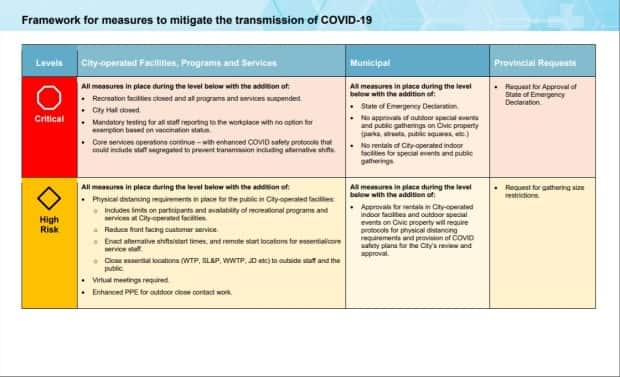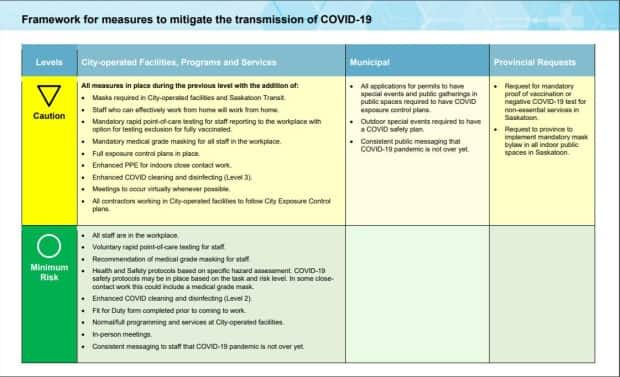Saskatoon city council to discuss new colour-coded classifications for COVID-19 risk level

Saskatoon city council will be discussing a new colour-coded COVID-19 mitigation framework in the wake of increasing case rates and hospitalizations in Saskatoon.
Under the proposed system, COVID-19 risk in the city would be classified using a four-colour scheme: green (minimal risk), yellow (caution), orange (high risk) and red (critical condition). Each colour would be associated with specific measures to combat the spread.
The city's governance & priorities committee voted in favour of the move Monday. It will now go to city council for consideration on Sept. 27.
The proposed framework uses four primary indicators: seven-day average weekly cases per 100,000 persons, seven-day average test positivity rate, effective reproduction rate and vaccination rates of the total population.
Other secondary indicators that would be monitored include hospitalizations, cases by age cohort, deaths and wastewater effluent analysis.

The test positivity rate in the city is currently 11.7 per cent. The seven-day case average per capita is 33 per 100,000.
The current effective reproduction rate is at 1.21. Mike Jordan, chief public policy and government relations officer, explained to council that this means "for every 100 people that are infected, they're going to infect another 120."
The vaccination rate sits at 60.2 per cent for the city.
These indicators would put Saskatoon in the orange classification level — which signifies high risk — and trending toward the red.
"Delta variant is quite high in terms of its concentration in wastewater and that's really what's driving the cases," Jordan said in the council meeting.
Projections show potential doubling of cases by month's end
Dr. Simon Kapaj, a medical health officer in Saskatoon, said short-term projections show a potential doubling of cases and hospitalizations provincially by the end of September. He said it will take at least two weeks or more to see the effects of the new public health measures, including mandatory masks for indoor public spaces and a proof-of-vaccination system that starts next month, if people comply.
The 20 to 29 age group has been showing a spike of cases. Since the province eliminated all public pandemic health measures on July 11, those 60 years of age and older have making up most of the hospitalizations. Unvaccinated people continue to be the largest proportion of cases.
"What I'm concerned about here is the fact that we are the hotspot of the province," Kapaj said in the meeting.
"We need to get things under control here to save the community."


Kapaj said tying mitigation strategies to each colour level in the new strategy would be helpful.
Saskatoon's being at orange level would mean physical distancing requirements for the public in city-operated facilities, limits on participants and availability of recreational programs and services at city-operated facilities, reduction of front-facing customer service and more.
Kapaj said this system is more transparent for the public.
"Higher the risk, higher the control"
Pamela Goulden-McLeod, the city's director of emergency management, said the mitigation measures are based on the hierarchy of controls and the level of risk.
"The higher the risk, the higher the control that's in place," she said in the meeting.
Goulden-McLeod said that Saskatoon's transit would be out of this framework and monitored separately. She said the framework would also not apply to the Albert Community Centre, Marr Residence, Mendel building, Saskatoon Police Service headquarters, Saskatoon Public Library locations, Sasktel Centre, Remai Modern and TCU Place.
She said some places would be under provincial jurisdiction in terms of health measures.
WATCH | Premier Scott Moe introduced sweeping new health measures last week
She said the new measures would be complementary to or in the absence of public health orders. If there are any provincial public health orders that provide direction, they would always take precedence.
"The goal of the implementation of this framework is to provide a clear understanding of trends, and transparency for our staff and residents of Saskatoon, as to what can be expected based on data driven set of indicators and measures," she said.
The city is presently gathering vaccination status for its staff. The mandatory COVID-19 rapid testing program for staff who report to the workplace, even for occasional visits, is anticipated to start on Oct. 4. All unvaccinated staff who report to a work site will be required to have a rapid test every seven days.
Council would convene a special meeting if and when the broad risk categories change.

